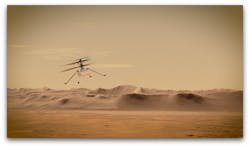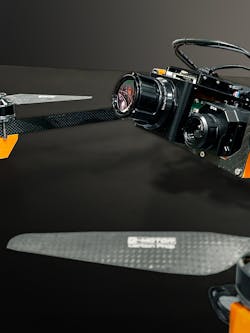Mars lander Perseverance has a helicopter drone friend named Ingenuity
In this week’s roundup from the Association for Unmanned Vehicle Systems International, which highlights some of the latest news and headlines in unmanned vehicles and robotics, the helicopter drone accompanying the Perseverance Mars rover and gas leak capture with UAVs and optical inspection systems.
Helicopter Drone to Test Flight on Mars
Thursday, February 18, 2021 marked a milestone in space exploration. The Perseverance Mars rover, accompanied by Ingenuity, an autonomous aircraft, have successfully landed on Mars. Perseverance will be searching the planet for signs of life and support a project that will lead to the collection of samples, which will be brought back for study. On a separate, but equally important mission, the helicopter drone will be performing test flights to inform future missions on Mars.
Ingenuity, the helicopter drone, was codeveloped by AeroVironment, in partnership with NASA’S Joint Propulsion Laboratory. The drone is solar-powered and outfitted with two cameras to capture images of the planet’s surface. This project is exclusively intended to demonstrate technological capabilities and test flight conditions in the Martian air, which has lower gravity and a very thin atmosphere.
Weather conditions on Mars are extremely harsh, therefore the vehicle and components must withstand these conditions and autonomously manage temperature. Tests will continue over a 30-Martian-day period.
Gas Imaging Inspection Improves Leak Assessments Offshore
Air Control Entech has developed an unmanned aerial vehicle designed to capture gas leaks with their optical gas imaging inspection system. The camera allows for high-definition imaging that will allow for leak detection that would not be possible with human vision. The system also features real-time data transfer which will improve safety through the early detection of leaks which could lead to fire or explosion.
Chief Operating Officer, Kieran Hope, states: “Now operators can visualize exactly where a gas leak has occurred as opposed to relying on sensing systems, which can only provide accuracy to within a 3-ft radius. In environments where winds can confuse sensing systems, seeing the leak rather than relying on sniffing for it has obvious benefits. Visual gas inspections were previously limited to either deck level or reduced use of UAV due to camera weight and flight time capacity. However, operators can now reach heights and sites that were previously inaccessible and can double flight time to increase valuable data gathering.”
The improvements to the system will reduce inspection costs and improve the accuracy of existing operations, having a tremendous impact on current operations.
Share your vision-related news by contacting Dennis Scimeca, Associate Editor, Vision Systems Design
SUBSCRIBE TO OUR NEWSLETTERS

